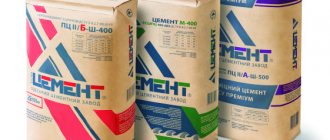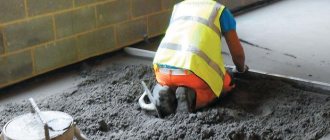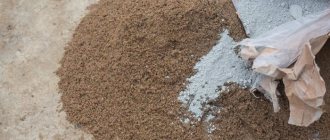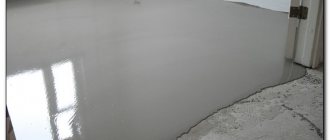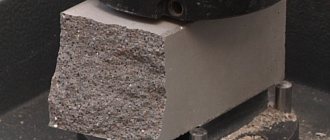Concrete - an important component of any construction. The operational characteristics of the structure being built largely depend on the foundation. Therefore, it is very important to properly prepare the solution for pouring it. Concrete mortar for large-scale construction projects is prepared in a factory.
Private developers, when building a house with their own hands, usually prepare it themselves in order to at least slightly reduce construction costs. Having chosen to prepare it yourself, it is important to observe the proportions for the concrete for the foundation. After all, the strength of the foundation of the house often depends on this.
Choice
The foundation is the load-bearing part of any building. To make it resistant to various loads, you need to choose the right composition of concrete for pouring it. In this case, its resistance to compression loads will be sufficient, which means it will be able to withstand the pressure of the entire house. Various grades of concrete are produced, so there are several composition options. Which one to choose for pouring the foundation? This question must be answered taking into account two factors:
- Features of the structure (number of floors, weight, size of the basement).
- Features of the soil on the site.
The choice of composition taking into account the first factor is made as follows:
- M 150 is used for pouring foundations for frame and panel buildings.
- For light houses made of logs and timber, M 200 is selected.
- M 300 for block and brick buildings.
The dependence on the characteristics of the site is as follows. The more complex the soil on the site, the higher the grade of concrete you need to choose. So, for rocky soil it is enough to prepare a solution of M 150. For loamy soil, the composition M 200 is suitable.
Types of foundations
The foundation for the construction of buildings is formed taking into account the load, types of soil, and structure. Depending on the type of foundation and its volume, the need for materials is calculated.
- The strip base is a closed loop made of reinforced concrete, placed under the load-bearing and internal walls of the building. How to make a solution for a strip foundation? To calculate the need for materials, you should determine the volume of each section and add them up. The mixture must be poured continuously, with layer-by-layer compaction and compliance with the protective layer of the reinforcement.
- The columnar type of base is used for lightweight structures located on dense soils. In practice, a combination of both types of foundation is often used.
- The slab type of foundation is practiced on weak, heaving soils. Made from reinforced concrete. Filling should be done in one go to prevent delamination of the finished structure. The concrete mixture is distributed evenly with mandatory compaction with vibrators or bayonet.
- Pile-rammed foundations. The volume of concrete is calculated using a geometric formula: the cross-sectional area of the well must be multiplied by the depth of the pile and the number of rods.
After pouring the concrete mixture into any type of base, it requires moisture, otherwise the structure may crack due to the rapid drying of the top layer. The first week should be regularly watered and covered with film or tarpaulin.
Related article: Tape and monolithic foundation slab
Do-it-yourself concrete for the foundation
You can use the materials separately or a ready-made sand-gravel mixture (proportions in buckets: 1 volume of cement per 5 volumes of mixture).
The components per 1m3 of concrete must be mixed in the following ratio:
- cement - 300-350 kg;
- crushed stone - 1200 kg;
- sand - 600-700 kg;
- water - 150-180 l.
Calculation of the amount of cement and sand, crushed stone and water should take into account the properties of the materials, their qualitative composition, strength, and the presence of foreign impurities (the sand may contain clay particles).
To properly make a cement mortar for pouring the base, pour dry components into a concrete mixer and mix for 2-3 minutes. Then, without stopping stirring, add water in portions. It is better to first dissolve the necessary additives in water. The mixing process should not be long, 5 minutes is enough.
Methods for calculating materials
The concrete recipe for the foundation includes the following components: cement, sand, gravel or crushed stone as fillers, and water. Each component is responsible for quality. In order for the final result to meet regulatory requirements, you need to correctly perform the calculation and determine the required number of components, observing the proportions.
Calculation of components and preparation of concrete for the foundation in buckets is relevant for small volumes of construction work, where 1-4 m 3 of solution is required. The basis for this calculation is usually the volumetric value of cement.
What should be the ratio of sand and cement for pouring a foundation?
Each component of the concrete mixture differs in volumetric weight, so in practice the following proportions are used: for 2 buckets of cement, take 5 buckets of sand and 9 of crushed stone or gravel.
A preliminary calculation of ingredients can be done using an online calculator in liters or kilograms. Emergency calculations are carried out taking into account the requirements for concrete and the characteristics of the main materials.
For example, to obtain 1 m³ of M200 concrete with a 180 liter concrete mixer, M400 cement, sand and crushed stone, you will need:
- water - 215 l;
- cement - 233 l;
- crushed stone - 818 l;
- sand - 389 l.
Under the given conditions, the calculator will calculate the need for materials for 1 batch and the number of loads.
When it is necessary to adjust the consumption of raw materials, taking into account the operating conditions of the structure being built, the type of mixture, the use of a plasticizer, the value of the coefficient of separation of concrete particles, it is necessary to use a correction table.
Components
Any concrete, regardless of its brand, consists of the following components:
- Cement.
- Sand.
- Crushed stones or gravel.
- Water.
All these components must have the necessary characteristics, taking into account which they must be selected. Cement is the main ingredient in a concrete mixture because it is a binder. It is produced by cement factories. Cement is divided by grade and by the number of various additives it contains. The most popular Portland cement, it contains many special additives to improve the properties of the material. When pouring the foundation of a house, experts recommend that private developers use cement M 400 or PC 400.
You need to keep in mind, like many building mixtures, the shelf life of cement is limited. After a year of storage in packaging, it significantly loses its activity, which determines the properties and brand of the material.
Sand is one of the aggregates in concrete mixtures. To obtain a high-quality solution, you need to take its choice seriously. It is worth noting that at the moment the choice of sand on the construction market is huge. If you wish, you can even purchase sand from the seabed, but not every sand material is suitable for concrete.
Thus, experts do not recommend using sand with clay admixtures for this purpose. Because of this, concrete is less durable and frost-resistant. But with river sand you can prepare a solution that is ideal in condition. It is often of very high quality and consists of homogeneous fractions.
Crushed stone and gravel , as well as sand in the solution, act as fillers. Thanks to them, the solution “shrinks” less, which makes the concrete structure stronger and more durable. When choosing crushed stone, you should pay attention to its shape. Because the convenience of pouring concrete mortar depends on it.
Flat and angular crushed stone is usually not used for mixing concrete. Because it requires more consumption of other components, which affects the strength of the structure. The best option for pouring the foundation is the use of crushed gravel. It consists of particles ranging in size from 3 to 70 mm. In addition, it is affordable for private developers.
Water. This component can have any characteristics, the main thing is that the water is clean without any impurities. Having all the above components and knowing the proportions of concrete for the foundation, you can prepare a solution of any required brand.
Types of concrete for pouring the base
To prepare a solution for the foundation, sand is suitable, the particle size of which varies from 1.2 to 3.5 mm. Bulk material without foreign impurities is used. A five percent clay and silt content is allowed, but this makes the concrete less durable.
The following experiment will help determine the quality of the composition: pour sand into a container, dilute it with water and shake the resulting solution thoroughly. If the water remains clear or loses a little transparency, it means the raw material is of high quality, and if it becomes very cloudy, it contains impurities. You can also leave the container to stand for a while. If clay sediment eventually appears above the sand, it is better not to use such bulk material for construction.
Thematic material:
- Proportions of concrete for the foundation in buckets
- Foundation concrete recipe
There should also be no impurities in the crushed stone composition. The particle size is 1-8 cm.
In the construction field, the following types of cement are distinguished:
- Portland cement (the most common option, which is used in the construction of various structures).
- Slag Portland cement (has high moisture resistance and frost resistance, but hardens more slowly).
- Pozzolanic Portland cement (used for the construction of structures under water and underground due to its exceptional moisture-resistant properties; in air conditions it shrinks strongly and loses strength).
- Fast-hardening cement (hardens in about 2 weeks; it is necessary to work with such material without delay, as it sets instantly, so this is not the best option for novice builders).
Thus, the most suitable material for self-filling a monolithic foundation for a house or other structure is Portland cement.
The following grades of cement are distinguished: ... PTs 500, PTs 500 D20, PTs 400 D20, PTs 400, etc. In accordance with the brand, the value of its compressive strength changes, which is determined for a concrete cube with sides of 20 cm and is measured in kg/cm2 .
Component proportions
The correct ratio of components in a concrete solution is the key to obtaining high-quality material. The optimal composition of concrete for the foundation for the construction of a private house is considered to be one part cement powder to four parts crushed stone (1/4). And in the proportion of cement and sand, the ratio is 1/3, that is, for 1 part of cement (M 400) there are 3 parts of sand.
In general, the weight of cement in the cement mortar should be 1/4 of the total mass. But concrete still needs water to harden. An important characteristic of concrete is the proportion of water and cement (the so-called water-cement ratio). The strength of concrete depends on this ratio: the lower its value, the stronger the material. For a concrete mixture used for concreting foundations, the maximum water-cement value is 0.75.
For private developers, for a small amount of work, it is easier to mix the mortar on the construction site. One batch of foundation mortar is made in a concrete mixer in approximately the following proportion:
- 300 kg of cement powder.
- 600 kg of sand.
- 1300 kg of crushed stone.
But the developer does not have the ability to weigh bulk materials when he is at the construction site. A completely reasonable question arises: how to make a foundation mortar correctly. To do this, you need to know the proportions of concrete for the foundation in buckets. Since all components have approximately the same bulk density, you can measure them and then the composition of the concrete for the foundation, the proportions in buckets will be something like this:
- Cement 25 buckets.
- Sand 43 buckets.
- Crushed stone 90 buckets.
When determining the amount of water, they are guided by the measure of cement: for one bucket of cement powder you need to add an incomplete bucket of water. This volume may vary depending on the situation. For example, if the formwork is reinforced, then the concrete is mixed with more plasticity so that it penetrates more easily into the frame.
Without reinforcement, it is more practical to make it rigid, this will speed up hardening. In both cases, you need to add enough water so that there are no puddles in the finished solution. To obtain one cube of concrete of different grades, the optimal ratio of components in volumetric terms is presented in the table.
| concrete grade | cement M 400 | sand | crushed stone |
| M 150 | 1 bucket | 3 buckets | 5 buckets |
| M 200 | 1 bucket | 2.5 buckets | 4 buckets |
| M 300 | 1 bucket | 1.7 buckets | 3 buckets |
In these volumetric indicators, the bucket can be replaced by any volume measure, provided that the proportion is maintained.
When deciding how to prepare concrete for the foundation, you need to keep in mind that in addition to the proportions, you need to know in what sequence to lay the components. First, water is poured into the concrete mixer, slightly less than normal. Then half a portion of crushed stone is poured. And only then, cement with sand and again all components are thoroughly mixed.
At the very end, the remaining crushed stone is poured. After this, you need to give the concrete mixer a little time so that it thoroughly mixes all the components. And finally, having assessed the thickness of the solution, depending on the situation, add the rest of the water or leave it as is and mix everything thoroughly again.
Preparing the mixture
Concrete is used in almost all areas of construction, when performing repair, construction or restoration work.
You can prepare the mixture for the foundation yourself by combining the components in a concrete mixer, bathtub, or box. When producing artificial material, it is important to follow the technology and proportions of concrete for the foundation.
Industrial production differs from artisanal production in large volumes, and therefore requires the use of special technical equipment. Mechanical preparation of concrete mixture for foundations by specialized enterprises makes it possible to improve properties and quality through additives.
When forming the foundation for building a house, you can use the services of a company that can prepare a concrete mixture using special equipment on the way to the customer.
To make a composition for the foundation with your own hands, you need to correctly determine the quantitative composition of the components. To obtain concrete grade 300 or 400, sand and cement are taken in proportions of 3:1, i.e. for 10 kg of cement you need to take 30 kg of sand, gravel (crushed stone) - 40-50 kg.
In this example, cement, sand, crushed stone weigh 80-90 kg, so 40-45 liters of water will be required to connect the components. You can mix the mixture using a mobile concrete mixer, a shovel or a construction mixer.
Preparation of concrete from a cement-gravel mixture requires adherence to technology. If the solution turns out to be dense, then it must be diluted with water to such a consistency that it can be stirred with a shovel without much effort. The amount of water is affected by the moisture content of the aggregates, so you should not add it all at once. It is better to do this in portions with constant stirring.
It is better to choose the warm season for concreting. At low temperatures, to improve the quality of concrete, you need to heat up the water, otherwise it may lose strength. And also use antifreeze additives.
Brands of cement mortars for the foundations of low-rise buildings
The brand of mortar for pouring the foundation is indicated in the specification or in the margins of the working drawings of the house or outbuilding project. Using this information and the capabilities of the Internet, you can quickly and completely free determine the proportion of cement and sand for the foundation in kilograms or liters for a particular brand of mortar. All that remains is to calculate the required volume of cement, sand and other components depending on the volume of pouring, purchase them, mix and pour the foundation.
Unfortunately, very often developers build country houses and private houses without a design. Accordingly, the question immediately arises: What are the proportions of cement for the foundation so that the structure can stand for a long time and withstand harmful factors? In this case, you should adhere to the following recommendations, based on the practical experience of many generations of private builders:
- Heavy concrete M150. Suitable for constructing a foundation for small-sized one-story buildings with walls made of cinder block, shell rock or aerated concrete. The specified grade of concrete can be used for pouring the foundation for garages and outbuildings.
- Heavy concrete M200. A universal brand of concrete suitable for the construction of foundations for 90% of low-rise buildings (one- or two-story buildings with light floors).
- Heavy concrete M300. This is a very durable concrete material with high load-bearing capacity. Used for the construction of foundations for large private houses up to 5 floors high.
Having decided on the brand of concrete, you can move on to considering a practical question: What proportions of cement and sand for the foundation should be used to prepare the selected brand of concrete?
Preparing a solution for pouring the foundation - the ratio of sand and cement
The choice of concrete proportions used for the foundation is influenced by many factors: soil parameters, expected loads, type of foundation. The basis of cement mortar is cement, sand, crushed stone or gravel and water; its properties directly depend on the quality and uniformity of mixing of the components. Changing the regulated ratios is unacceptable; the slightest errors lead to a decrease in the strength of the foundation and, as a consequence, the risk of destruction of the load-bearing structures of the building.
Choosing a concrete grade
The main criteria include the geological conditions of the site (relief, level and partial pressure of groundwater on foundation elements, climate, freezing depth), type of foundation, presence or absence of a basement, height of the building and other weight loads. The limiting factor is the work budget; using high-quality types of concrete for the construction of light buildings on summer cottages is not economically feasible. The recommended minimum is:
- M400 – for houses over 3 floors.
- M200-M250 – for frame and panel buildings.
- M250-M300 – for buildings made of wooden beams.
- M300 - for low-rise buildings made of expanded clay, gas silicate or cellular blocks.
- M350-M300 - when building with brick or pouring load-bearing walls made of monolithic concrete.
The specified gradations are relevant when constructing one- or two-story houses; when adding another floor, it is advisable to choose a higher grade. The same applies to ready-made purchased solutions, especially if purchased from an unverified manufacturer. In general, the minimum permissible strength when concreting the foundations of residential buildings on slightly heaving soils is M200; when building on less stable soils, it increases.
